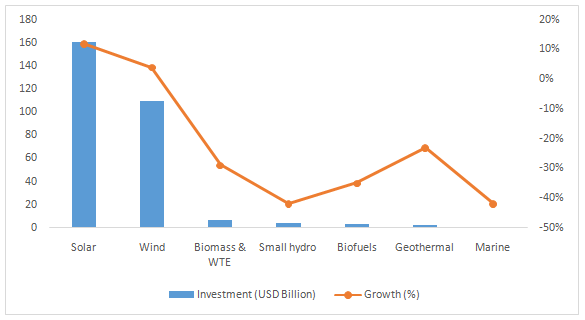BIPV And BIOPV Market: Increasing Adoption Of Aesthetic Solar Energy Harnessing Systems Is Expected To Drive Demand
Building integrated photovoltaics typically comprise a stacked solar panel that is amalgamated onto the surface of a building. The solar panels can be installed on roofs, facades, walls, and glass windows. The demand for building integrated networks has witnessed a significant growth over the past four years owing to the substantial demand for the product for commercial and industrial installations.
The demand for building integration is expected to be driven by the increasing roof and wall integrations of the solar panels with the building surface. Furthermore, technological advancements related to the development of BIOPV which offers superior efficiency as company to conventionally integrated PV is expected to propel growth.
Building Integrated Organic Photovoltaics (BIOPV) is expected to emerge as one of the fastest growing technology segment in the global market. The segment has witnessed significant investments in the production technology in the technology. In addition, the manufacturing technology used for the production of BIOPV is less energy intensive in comparison to the crystalline silicon.
Global new investment and growth in renewable energy by sector, 2015 (USD Billion) (%)

The product is ideally suited for integrated curtain walls and provides superior properties such as high temperature performance coupled with superior low light sensitivity. This leads to a high demand for the product over the forecast period. Furthermore, the higher energy band gap for OPVs is expected to increase the operational efficiency for the product.
The market exhibited a high affinity of the consumers to integrate the building roofs with the solar panels. Roof integration offers superior benefits such as higher operational area coupled with the development of high strength integrations to support medium to high weight. In addition, increased aesthetic appeal of the structures installed with BIPVs is expected to drive the demand for installations in building facades.
The demand for such installations is expected to increase with the growing efforts by the national governments, encouraging the use of renewable energy resources. In addition, significant tax reductions coupled with substantial subsidies offered, for the use of BIPV panels is likely to drive the market growth over the next eight years.
The market is expected to be restrained by the high installation cost of the BIPV and BIOPV installations. The cost of such installations is increased by the high cost of products installed coupled with the cost incurred labor cost of installations. The installation of the integration during the conceptualization of the building design incurs less cost and provides higher economic benefits to the consumers.
The demand for the product is expected to be driven by growing concerns regarding the use of non-renewable sources of energy. Increasing industrial and commercial installations of the integrated solar energy harnessing solution is expected to drive the demand for the product. Increased technological innovations have resulted in the development of the advanced products such as the organic photovoltaics, which provide superior efficiency on account of higher energy band-gaps.
The demand for the products is expected to be driven by the growing adoption of the solar energy system, primarily by the developing economies in Asia Pacific coupled with the growth of the construction sector in the region. Low cost of the product in the region is also expected to benefit the market growth over the forecast period. India is expected to emerge one of the fastest growing economies in the region due to growing disposable income of the consumers.
 In-depth report on global BIPV market by Grand View Research:
In-depth report on global BIPV market by Grand View Research:
https://www.grandviewresearch.com/industry-analysis/building-integrated-photovoltaics-bipv-market